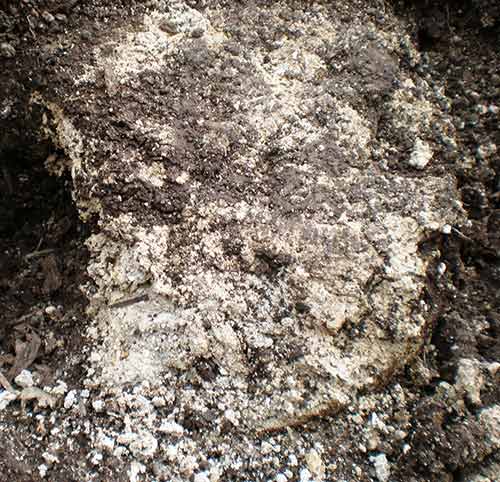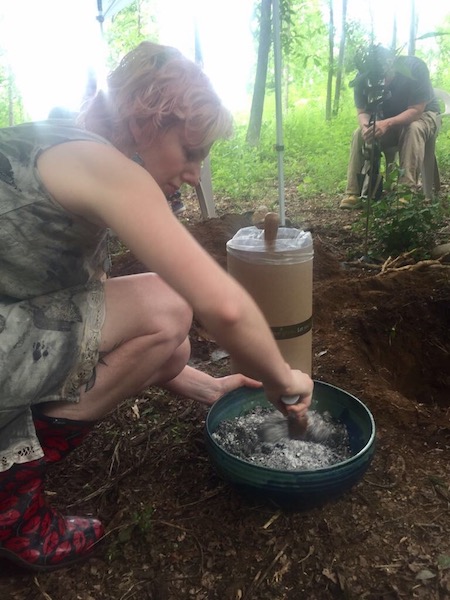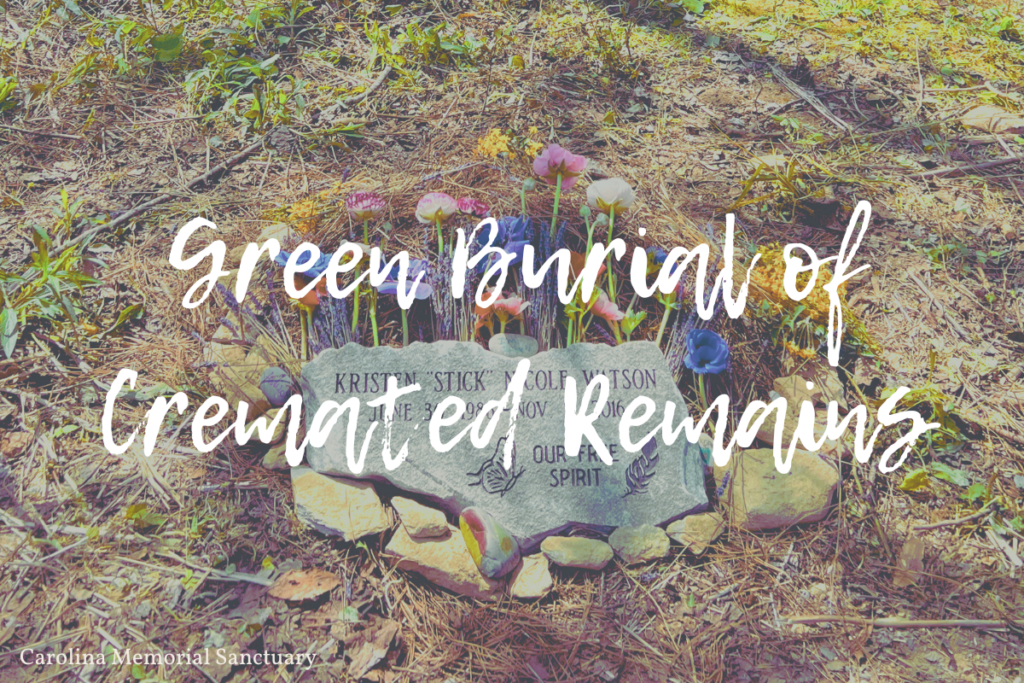When considering disposition— what to do with one’s body after death— people generally fall into one of two camps: burial or cremation. Many factors go into the decision: cultural or familial tradition, cost, geographical location (lack or abundance of cemetery space), environmental impact, and personal preference. For those who opt for cremation, people typically scatter the remains or purchase an urn for burial or to keep in the home. There are other less traditional options. Ashes can also be incorporated into a piece of jewelry or as decorative blown glass, added to fireworks, flown out to space—the list goes on. If you desire a final resting place for loved ones to visit and you are an advocate for green burial, there are options for green burial of cremated remains as well!
Cremated Remains and Soil
In order to understand the methodology behind green burial of cremated remains, it’s important to understand the chemical components of cremated remains (otherwise known as “cremains” or “ashes”). Cremated remains contain high levels of calcium, phosphate and sodium, and as a result, are naturally salty and alkaline. While plants do require phosphates, calcium, potassium and sodium to thrive, these minerals are present in such high rates within cremated remains that when buried, the root structures of nearby plants will actively avoid this contaminated area, opting for more chemically balanced soil. Here is a photo of ashes that were placed in a biodegradable urn 16 months after burial – you can see that they have remained completely intact:

Green Burial & Scattering of Cremated Remains at Carolina Memorial Sanctuary
In both scattering and burial, the way to address the naturally high alkalinity and salinity of cremated remains is to add a soil amendment. Given Carolina Memorial Sanctuary’s status as a conservation and green cemetery, our standards are strict: we opt for only the most ecologically sound product on the market. Soil amendments offer the perfect solution for the ecological problem posed by cremated remains. Adding a soil amendment not only lowers the acidity of cremains, it also dilutes the amount of salt naturally found in the cremated remains. Here at CMS, we use Let Your Love Grow, an amendment designed specifically for the green burial of cremated remains. In addition to helping balance the pH and dilute the salt, Let Your Love Grow claims to contain a beneficial bacteria which penetrates the calcium of the cremated bone and allow it to be absorbed by surrounding vegetation.
Scattering
Even scattering of ashes can be harmful to plants, resulting in scorching, due to the high alkalinity of cremated remains.3 (We’ve seen this first hand at the Sanctuary.) Some families and individuals prefer scattering ashes instead of burying them. At Carolina Memorial Sanctuary, we offer our guests the opportunity to scatter their loved one’s cremated remains at one of several designated mature trees on our property. When we do a scattering, we also amend the cremated remains with Let Your Love Grow, however it needs to be mixed and sit for 120 days before the scattering occurs since the mixture will be scattered directly on top of plantlife; if we didn’t take this precaution, the cremated remains could harm the plants.
Pet Ashes
A common question we get when someone has chosen burial of cremated remains is whether the ashes of their pets can be buried with them. The answer is YES! Based on the amount of additional ashes added (we’ve had multiple pets added to their human’s grave) —we may need to add additional soil amendment, which would incur a slight increase in cost.
Participating in the Burial Ceremony
One of the things that makes green burial so special is the intentional process of inviting guests to be hands on in the burial process. When doing a burial of cremated remains at the Sanctuary, guests are invited to personally mix the cremains of their loved one with the soil amendment at the gravesite, in one of our beautiful ceremonial bowls. The mixture is then added directly into the grave (an urn isn’t used). Afterward, we take turns placing earth back into the grave until the grave is fully closed. Folks have the option of bringing fresh cut flowers, which can be used to decorate the grave. And if the family has arranged it ahead of time, they can pick a stone from the selection we provide and have it engraved, so that the engraved stone can also be placed at the grave during the burial process. As always, we encourage our guests to be as involved with the burial as possible (up to their comfort level).

While we currently enjoy and thoroughly endorse Let Your Love Grow, we anticipate that the technology of soil amendments will continue to improve. If and when they do, we will update our product accordingly: we remain committed to the most ecologically sound solutions, while keeping in mind what’s best for your budget. For more information on the cost of burial of cremated remains, please see our price list. A soil amendment is included in a purchase of a burial or scattering of cremated remains.
The Environmental Impact of Flame Cremation
Just how environmentally sound is cremation? While it’s true that flame cremation poses a lower climate impact than conventional burial, there is still a negative environmental impact. When a person is cremated, the retort (the oven) is heated to approximately 1900ºF and it takes around 2 hours to perform a single cremation. That is a lot of fuel, the equivalent of driving a car 550 miles. Additionally, the process of cremation releases roughly 250-350 pounds of carbon dioxide (1.74 billion lbs of CO2 emissions annually in the US), which contributes to greenhouse gasses. Byproducts include nitrogen oxide, dioxins and other particulates, which contribute to acid rain. For individuals who have mercury dental fillings, the filling turns into mercury gas, contaminating both air and waiter. For people who lean more towards cremation than burial but don’t like the negative environmental impacts of flame cremation, a newer technology known as water cremation, or aquamation, is less harmful to the environment.
A More Earth Friendly Alternative: Water Cremation/Aquamation (Alkaline Hydrolysis)
Aquamation, also known as alkaline hydrolysis, offers the best of both worlds: the convenience of cremation with a truly low environmental impact. Using a combination of water, lye and pressure, aquamation breaks down the body into the same byproducts left behind by cremation (namely, bone), without the use of chemicals and with a significantly lower carbon footprint. The leftover bone is pulverized in the same manner as the bone fragments and ash left over from flame cremation, so what you’re left with is something that looks very similar to ashes, except they are whiter with a larger volume of remains. Aquamation is becoming more widespread, for example, it was the choice of disposition for Desmond Tutu. It is important to note, however, that aquamation isn’t a perfect environmental solution as one of the key ingredients, potassium hydroxide (lye), is sourced through mining. But compared to flame cremation, it does appear to be the more environmentally friendly choice. A natural full body burial is still the option with the least negative environmental impact. Aquamation was legalized in North Carolina in 2019 and one of our local partners, Groce Funeral Home, is happy to announce that they are now offering aquamation services. Clay-Barnette Funeral Home, located in nearby Shelby, offers both human and pet aquamation services.
Burial or Cremation?
So, burial or cremation? They each have their pros and cons. The choice for the final disposition of your body is very personal. What is important is that you’ve done your research, know your options, and can make an informed choice about what is right for you – and communicate that choice to your loved ones. We are proud to champion a green option for disposition of cremated remains and will continue to support our guests who choose cremation, seek a final resting place, and are committed to practices that honor the earth.
Originally published 10.25.17. Updated 3.29.23.

